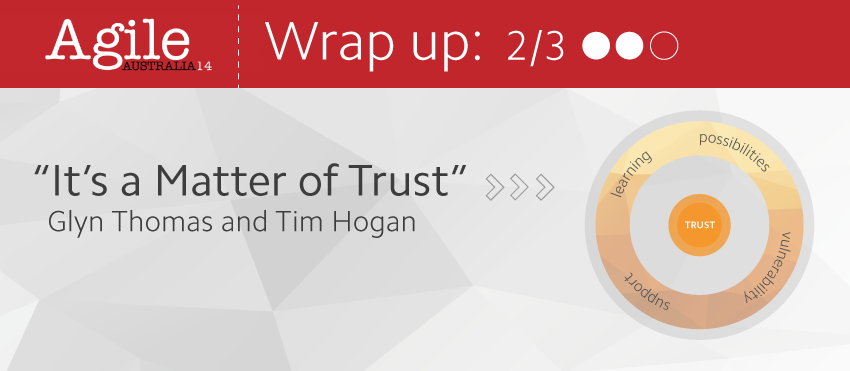As a follow up to my previous micro-blog on Agile Australia 2014 (You are your Process – Jim Benson), I thought I’d share another valuable and enjoyable talk I attended on Day 2 of the conference.
Glyn Thomas and Tim Hogan’s presentation was all about trust: what it is and how it’s developed. Taking us step-by-step through some of their research, this fascinating topic resonated strongly with me. Here’s an overview of their observations:
What makes a good team?
Glyn and Tim started off with this important question, identifying the elements of a good team as:
- Motivated individuals
- The right environment
- Support for the team
- An organisation that trusts them.
Funnily enough, these elements can also be found in the 12 Agile principles:
“Build projects around motivated individuals. Give them the environment and support they need, and trust them to get the job done.”
Unfortunately, trust seems to be a missing factor for many teams – either between individuals or from the organisation. However, Glyn and Tim’s talk specifically focused on team interactions.
So what does trust look like?
Glyn and Tim’s research asked: Is trust just a willingness to be vulnerable with others? It certainly can’t be constrained to a thing, action or management technique.
They came to the conclusion that it’s an environment fostered by team members and their relationships with each other. This environment should include:
- Vulnerability – that it’s OK to fail
- Supporting each other
- Learning with each other
- Focusing on the possibilities and not on the potential losses.
Sometimes it’s hard to identify this environment and what trust looks like. Too often we see its opposite in the workplace: mistrust.
What are the signs of mistrust?
When people mistrust others they often develop a thick skin and think they can do it on their own. This can be constraining and wasteful for a team – a point Glyn and Tim emphasised as a key outcome of lack of trust.
I’m sure there’s been a time in your career where you would agree with this statement. The key question here is:
Why would you hire someone to do a job and then not lot them do their job?
Building trust requires action from everyone within the team. There are a number of ways you can build trust and avoid the wastefulness of mistrust.
Physiological ways of building trust with others produce oxytocin (sometimes known as the “bonding hormone”). Interestingly, producing oxytocin can be as simple as smiling and maintaining eye contact.
Glyn and Tim’s research also demonstrated that talking about trust actually builds trust – either by asking for it straight out (i.e. “Can you trust me on this one?”), or in a more structured format where the whole team specifically discusses the topic of trust.
A fascinating though less work appropriate way is via physical contact (i.e. a hug), particularly if the hug is 20 seconds or longer. Perhaps we can settle for a solid handshake instead?
Finally, Glyn and Tim highlighted Agile principles/practices have built-in activities that foster a trusting environment:
- Retrospectives require a team to open up and talk about how things are going within the team
- Showcases or Reviews mean a team must be vulnerable enough to demonstrate what they’ve been working on and be open to feedback.
The presentation concluded with a straightforward call to action for the audience, and one worth remembering in our work lives:
Trust… it’s in your capable hands.
Slides to Glyn and Tim’s presentation can be found here: >> view slides

